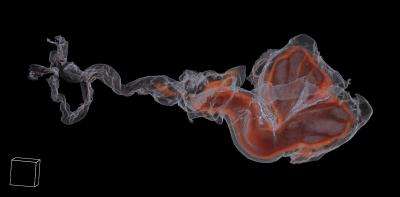An intimate look at the mechanics of dolphin sex

Earth's creatures outwardly display an astonishing diversity of genitalia and mating behavior, but the intricate details of how genitalia interact during copulation has remained largely mysterious. In a new study, researchers deploy inventive new techniques to decipher the internal dynamics of copulation. They demonstrate the approach in multiple species of marine mammals, which are animals known to have unusually shaped genitalia.
Dara Orbach, PhD, a postdoctoral fellow at Dalhousie University and research associate at Mount Holyoke College, will present the work at the American Association of Anatomists annual meeting during the Experimental Biology 2017 meeting, to be held April 22-26 in Chicago.
"While it may seem intuitive that the penis fits well into the vagina during copulation, the biomechanics and details of the anatomical fit can be quite complex and have seldom been explored," said Orbach. "Whales, dolphins and porpoises have unusual vaginal folds, spirals and recesses that the penis and sperm must navigate through to successfully fertilize the egg."
After obtaining reproductive tracts from dolphins, porpoises and seals that died naturally, Orbach and her colleagues developed a system to inflate the penises to full erection and simulate copulation with vaginal tissue samples. They then used computed tomography (CT) scans to visualize how deeply the penis penetrates the vagina and which anatomical landmarks are in contact. They also created silicone models of the interior of the dolphin vagina to explore how its shape might have coevolved with the shape of the male penis.
"Most previous research on genitalia has focused on the penis," Orbach said. Studying the genital diversity of both sexes together—including how they interact during copulation—is crucial to understand evolutionary driving forces. Marine mammals offer an especially interesting case study in the evolution of copulation because these animals must contend with some unique constraints, such as the challenge of mating while swimming in 3-D space and the need to prevent seawater from entering the uterus.
Orbach said studying animal copulation also has practical benefits, particularly in the context of conservation.
"The techniques we have developed can be applied to other species and help advance captive breeding programs," said Orbach. "For example, we demonstrate that particular anatomical landmarks are in contact during copulation and suggest that physical stimulation of these landmarks during artificial insemination may improve the probability of conception. Our research can also help predict which natural copulations will lead to fertilization, as males must sexually approach females at specific angles to optimize their genital alignment and penetration."
More information: Experimental Biology 2017 meeting, app.core-apps.com/eb2017/abstr … e96fd9b31960991c8993
Provided by Experimental Biology 2017



















